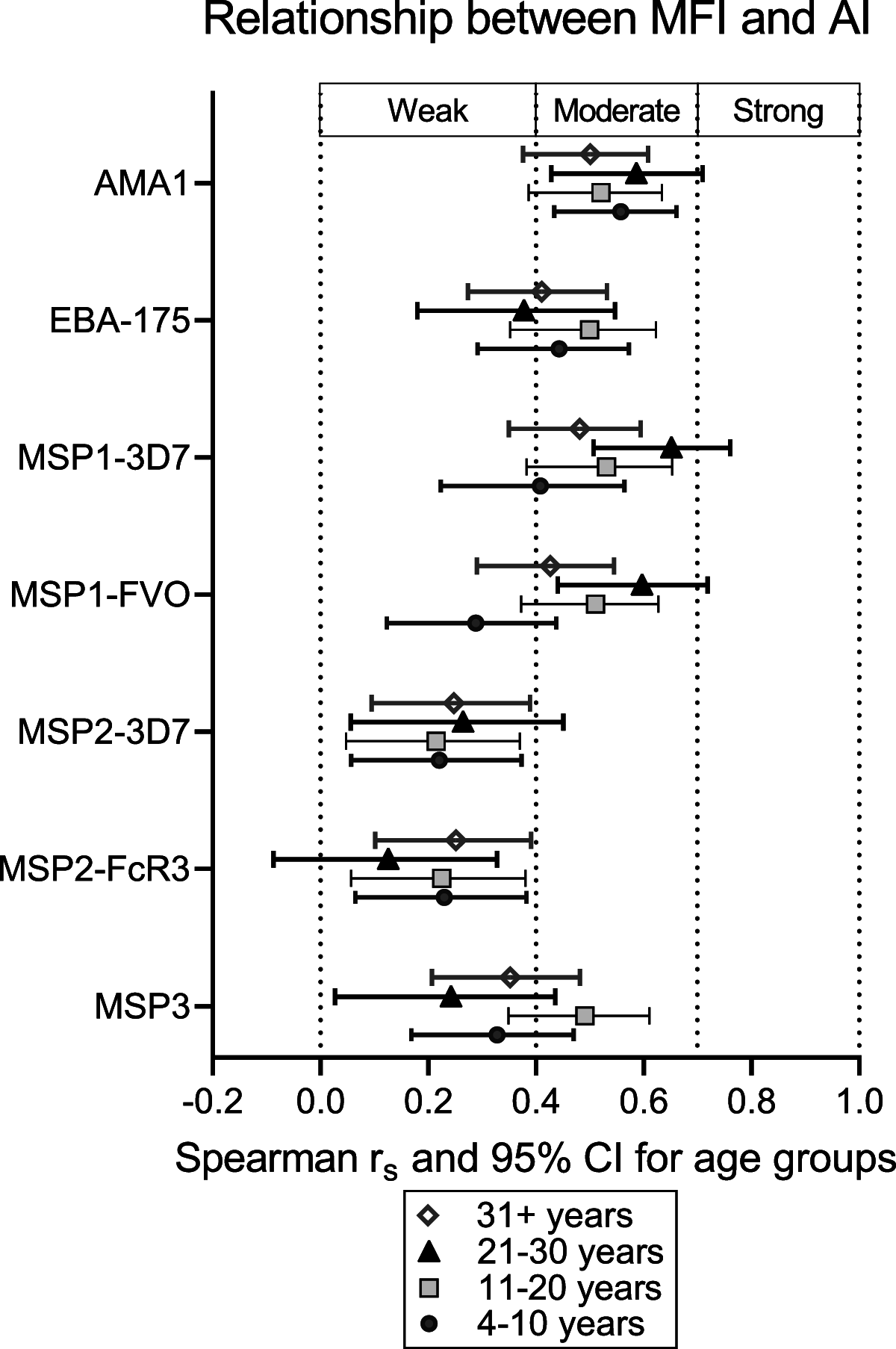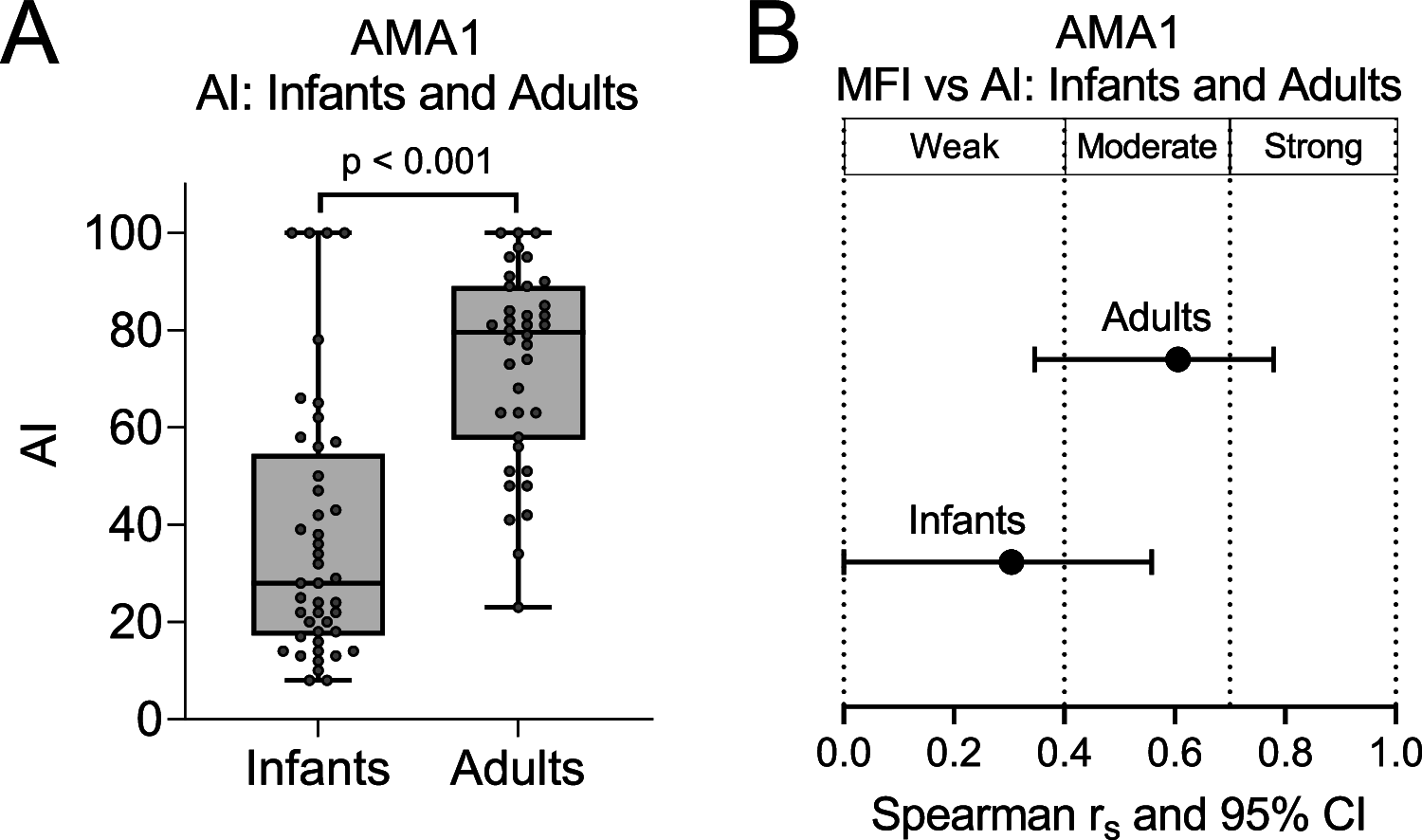Does Antibody Avidity to Plasmodium falciparum Merozoite Antigens Increase with Age in Individuals Living in Malaria-Endemic Areas?
- PMID: 33722929
- PMCID: PMC8315941
- DOI: 10.1128/IAI.00522-20
Does Antibody Avidity to Plasmodium falciparum Merozoite Antigens Increase with Age in Individuals Living in Malaria-Endemic Areas?
Abstract
High-avidity antibodies (Abs) are acquired after a few Plasmodium falciparum infections in low transmission areas, but it remains unclear if Ab avidity to different merozoite antigens increases with age in individuals with persistent antigenemia and, if so, when a fully mature Ab response occurs. The study used plasma samples collected between 1996 and 1998 from 566 individuals aged 4 to 84 years in Simbok, Cameroon, where residents received an estimated 1.6 infectious mosquito bites/person/night. Plasma samples were examined for Ab levels (median fluorescence intensity [MFI]) and Ab avidity index (AI) (where AI = [MFI after treatment with 2 M NH4SCN/MFI without salt] × 100) using a bead-based multiplex immunoassay for recombinant AMA1, EBA-175, MSP1-42 (3D7, FVO), MSP2 (3D7, Fc27), and MSP3. Blood-smear positivity for P. falciparum declined with age from 54.3% at 4 to 5 years to 18% at 16 to 40 years and <11% at >40 years of age, although most individuals had submicroscopic parasitemia. Ab affinity maturation, based on age-related patterns of median AI, percentage of individuals with AI of ≥50, and strength of association between MFI and AI, occurred at different rates among the antigens; they developed rapidly before age 4 years for AMA1, increased gradually with age for EBA-175 and MSP1 until ∼16 to 25 years, but occurred negligibly for MSP2 and MSP3. In a hyperendemic area with perennial transmission, affinity maturation resulting in an increase in the proportion of high-avidity Abs occurred for some merozoite antigens, in parallel with a decline in malaria slide passivity, but not for others.
Keywords: antibody avidity; malaria; merozoite antigens.
Copyright © 2021 American Society for Microbiology.
Figures







Similar articles
-
Measuring antibody avidity to Plasmodium falciparum merozoite antigens using a multiplex immunoassay approach.Malar J. 2020 May 1;19(1):171. doi: 10.1186/s12936-020-03243-3. Malar J. 2020. PMID: 32357882 Free PMC article.
-
High affinity antibodies to Plasmodium falciparum merozoite antigens are associated with protection from malaria.PLoS One. 2012;7(2):e32242. doi: 10.1371/journal.pone.0032242. Epub 2012 Feb 21. PLoS One. 2012. PMID: 22363818 Free PMC article.
-
Avidity of anti-malarial antibodies inversely related to transmission intensity at three sites in Uganda.Malar J. 2017 Feb 10;16(1):67. doi: 10.1186/s12936-017-1721-3. Malar J. 2017. PMID: 28183299 Free PMC article.
-
Individuals living in a malaria-endemic area of Cameroon do not have an acquired antibody response to Plasmodium falciparum histidine-rich protein 2.Malar J. 2017 Feb 1;16(1):58. doi: 10.1186/s12936-017-1704-4. Malar J. 2017. PMID: 28148260 Free PMC article.
-
Antibody Correlates of Protection from Clinical Plasmodium falciparum Malaria in an Area of Low and Unstable Malaria Transmission.Am J Trop Med Hyg. 2020 Dec;103(6):2174-2182. doi: 10.4269/ajtmh.18-0805. Epub 2020 Oct 27. Am J Trop Med Hyg. 2020. PMID: 33124533 Free PMC article. Review.
Cited by
-
Profiling the Quality and Quantity of Naturally Induced Antibody Responses Against Pfs230 and Pfs48/45 Among Non-Febrile Children Living in Southern Ghana: A Longitudinal Study.Front Cell Infect Microbiol. 2021 Nov 25;11:770821. doi: 10.3389/fcimb.2021.770821. eCollection 2021. Front Cell Infect Microbiol. 2021. PMID: 34900755 Free PMC article.
References
-
- Hedman K, Lappalainen M, Soderlund M, Hedman L. 1993. Avidity of IgG in serodiagnosis of infectious diseases. Rev Med Microbiol 4:123–129. 10.1097/00013542-199307000-00001. - DOI
-
- Ibison F, Olotu A, Muema DM, Mwacharo J, Ohuma E, Kimani D, Marsh K, Bejon P, Ndungu FM. 2012. Lack of avidity maturation of merozoite antigen-specific antibodies with increasing exposure to Plasmodium falciparum amongst children and adults exposed to endemic malaria in Kenya. PLoS One 7:e52939. 10.1371/journal.pone.0052939. - DOI - PMC - PubMed
Publication types
MeSH terms
Substances
Grants and funding
LinkOut - more resources
Full Text Sources
Other Literature Sources

